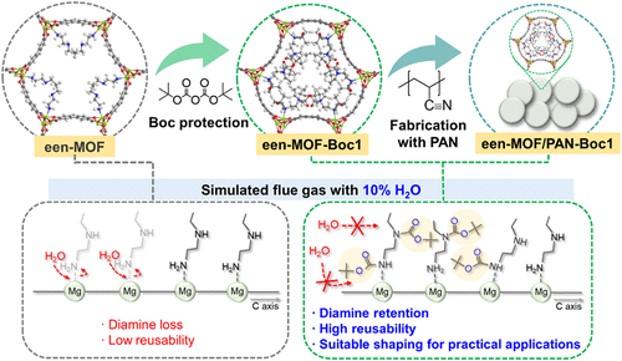Among the various metal–organic framework (MOF) adsorbents, diamine-functionalized Mg2(dobpdc) (dobpdc4– = 4,4-dioxidobiphenyl-3,3′-dicarboxylate) shows remarkable carbon dioxide removal performance. However, applying diamine-functionalized Mg2(dobpdc) in practical applications is premature because it shows persistent performance degradation under real flue gas conditions containing water vapor owing to diamine loss during wet cycles. To address this issue, we employed hydrophobic carbonate compounds to protect diamine groups in een-Mg2(dobpdc) (een-MOF, een = N-ethylethylenediamine). tert-Butyl dicarbonate (Boc) reacted rapidly with diamines at the pore openings of MOF particles to form dense secondary and tertiary hydrophobic amines, effectively preventing moisture ingress. The Boc-protected een-MOF-Boc1 maintained excellent CO2 adsorption even under simulated flue gas conditions containing 10% H2O. This observation indicates that Boc protection renders een groups intact during repeated wet cycles, suggesting that Boc-protected een groups are resistant to replacement by water molecules. To increase the practicability of the MOF adsorbent, we fabricated een-MOF/PAN-Boc1 composite beads by shaping MOF particles with polyacrylonitrile (PAN). Notably, the composite beads maintained their CO2 adsorption performance even after repeating the temperature swing adsorption process more than 150 times in 10% water vapor. Furthermore, breakthrough tests showed that the dynamic CO2 separation performance was retained under humid conditions. These results demonstrate that Boc protection provides an easy and effective way to develop promising adsorbents with high CO2 adsorption capacity, long-term durability, and the properties required for postcombustion applications.

 High Hydrogen Storage in Trigonal Prismatic Monomer-Based Hig...
High Hydrogen Storage in Trigonal Prismatic Monomer-Based Hig...
 Double-Walled Tubular Heusler-Type Platinum–Ruthenium Phosphi...
Double-Walled Tubular Heusler-Type Platinum–Ruthenium Phosphi...

















